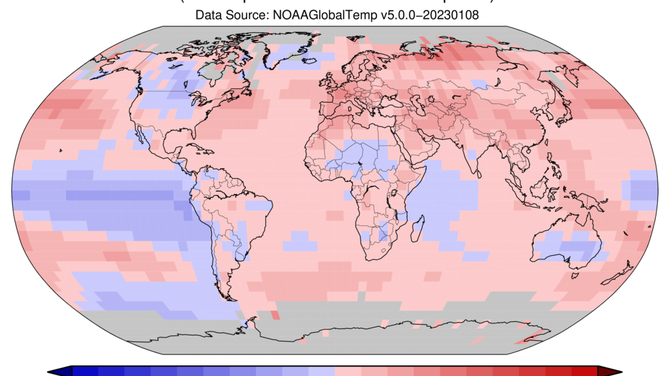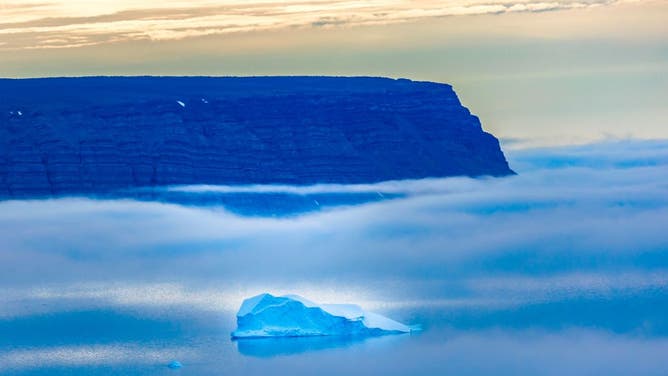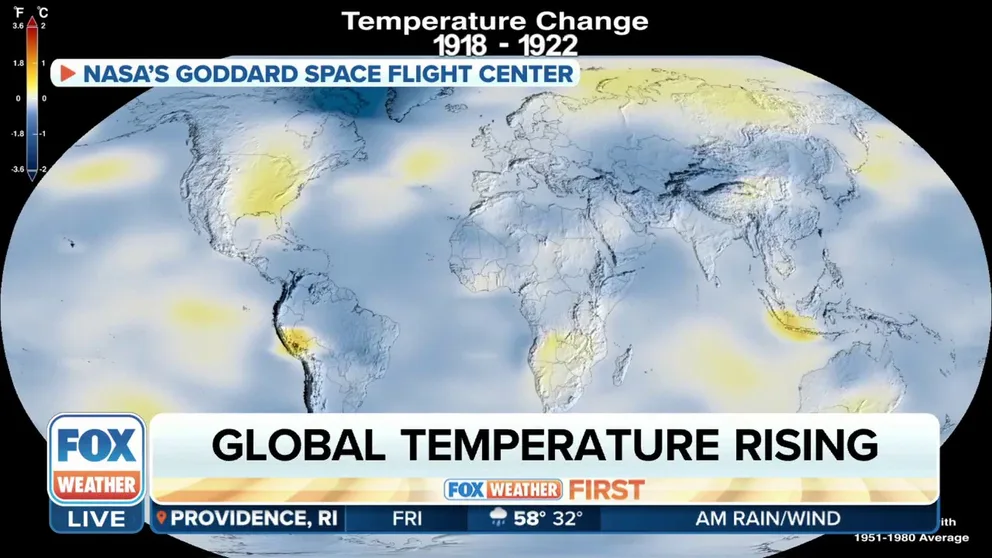NOAA climate report finds 2022 was Earth's 6th warmest on record
According to NOAA, 2022 was the third-costliest year for the U.S. in weather and climate-related disasters, exceeding $165 billion in damage. NASA and NOAA climate reports highlight continued warming trends and depleting sea ice levels.
NOAA climate report finds 2022 was one of Earth's warmest on record
NASA Climate Scientist Dr. Patricia Lawston Parker talks about the annual assessments of global temperatures and where 2022 ranks for hottest year on record.
NOAA scientists say significant climate disasters, diminishing sea ice and a consistently warming ocean were all on display in 2022, Earth's 6th warmest since modern record-keeping began.
NOAA and NASA released their 2022 climate and temperature analysis on Thursday, using data from land, sea, sky, space satellites and animal tracking to show the ocean temperature, sea ice levels and more.
NOAA ranked 2022 as Earth's 6th warmest on record with a .86 degrees Celsius (1.55 degrees Fahrenheit) increase.
Meanwhile, a similar but separate analysis of the data by scientists at NASA's Goddard Institute for Space Studies determined 2022 tied with 2015 for Earth's fifth-warmest year.
The slight difference between NOAA's and NASA's findings is because of the baseline the agencies used to determine the yearly average temperature.
NASA said 2022 was .89 degrees Celsius (1.60 degrees Fahrenheit) warmer than the baseline from 1951-1980. NOAA's average uses a baseline established between 1901 and 2000.
Last year was slightly warmer than 2021, by .02 degrees Celsius. Still, Chief of NOAA's National Centers for Environmental Information's analysis and synthesis branch Russell Vose said the ranking is only a "tiny part of the story."
Overall, current temperatures are about 1.1 degrees Celsius warmer than in the late 19th century, with the last eight years being the warmest.
HERE'S WHY THE US HAS THE LOWEST SNOW COVER IN OVER A DECADE
"If you look back a little further … it's clear that each of the past four decades has been warmer than the decade that preceded it," Vose said. "There's really been a steady, steady rise in temperature since at least the 1960s."
Climate scientists say the reason for the continued warming is human activity driving greenhouse gases into Earth's atmosphere.
Earth's ‘hot tub’

The 2022 average temperature across global surfaces was 1.55°F (0.86°C) above the 20th-century average of 57.0°F (13.9°C) – the sixth highest among all years in the 1880-2022 record. (image: NOAA)
(NOAA)
Vose dove head first into "the hot tub," explaining ocean temperature data is one of the best ways to measure climate change, which has been on a steady upward warming trend since the 190s, according to NOAA.
"It's essential for understanding and modeling global climate because the oceans actually store 90% of the excess heat in the Earth's system," Vose said.
Measurements to determine the ocean's heat content are taken from various depths using a variety of instruments, including some instruments on marine mammals.
WETTER, STORMIER ARCTIC LEADS TO SIXTH WARMEST YEAR ON RECORD
Last year the world's oceans again hit a record with the highest temperatures since record-keeping began. Since about the 1970s, each decade has been warmer than the last.
"The heat just keeps stacking up," Vose said.
Most of Earth's global ocean has been above average, but a large swath of the tropical eastern Pacific is well below normal because of the phenomenon called La Niña.
Climate-related disasters rack up billions in damages
Countdown: Top 10 biggest weather stories of 2022
FOX Weather took a look back at the biggest weather events of 2022 and picked the 10 most impactful events. Meteorologists Amy Freeze and Jason Frazier takes us through the year.
Warmer ocean temperatures can also mean more tropical systems like Hurricane Ian, now ranked as the third most costly U.S. hurricane on record. Last year, global tropical cyclone activity was near average, with 88 named storms.
The NOAA and NASA climate reports tallied climate-related impacts from 2022 ranging from drought to extreme heat and costly natural disasters.
According to NOAA Chief Scientist Sarah Kapnick, 2022 was the third-costliest year for the U.S. in weather and climate-related disasters, exceeding $165 billion in damage.
"In the US, we have consistently had both the highest total counts, more than any other country each year, and the largest diversity of different types of weather and climate extremes that lead to billion-dollar disasters," Kapnick said.
Last year saw scores of extreme weather events, including U.S. wildfires, winter storms in Europe, flooding in Australia, South Africa and Pakistan and hailstorms in France.
According to NOAA, Asia and Europe experienced their second-warmest year on record.
Arctic warming and sea ice melt continue

Icebergs seen through the fog float in the Baffin Bay near Pituffik, Greenland on July 20, 2022 as captured on a NASA Gulfstream V plane while on an airborne mission to measure melting Arctic sea ice. New observations from ICESAT-2 show remarkable Arctic Sea ice thinning in just three years. (Photo by KEREM YUCEL/AFP via Getty Images)
(Getty Images)
Another bellwether of climate change is Arctic sea ice, which is warming between 3.5 and 4 times as fast as the rest of the globe, said Director of NASA's Goddard Institute for Space Studies Gavin Schmidt.
In the Arctic, the 2022 average was 4.13 million square miles, the 11th lowest since the 1979-2022 record, according to the National Snow and Ice Data Center. December alone saw its seventh-lowest average, with 4.6 million square miles.
HOW TO WATCH FOX WEATHER ON TV
Depleting sea ice is happening throughout all seasons.

Arctic sea ice extent for December 2022 was 4.60 million square miles. The magenta line shows the 1981 to 2010 average extent for that month. (Image credit: National Snow and Ice Data Center)
(NOAA)
In 2022, data showed a 10% decrease in sea ice in March and about a 40% decrease in September.
On the other pole, the Antarctic sea ice extent was the second-lowest on record at 4.09 million square miles.
Scientists are forecasting 2023 to continue on the same warming trend.
"As for next year, well, you never know," Vose said. "Barring a major volcanic eruption, though, it's probably going to be pretty warm. There's almost a 100% chance we'll be in the top ten again."

